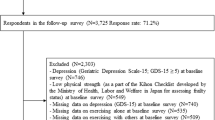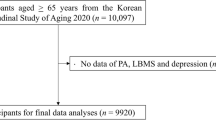Abstract
Purpose
The present study aimed to analyse the effects of 12 months of participation in a public physical activity program linked to primary care on depression level and fitness, and to determine which fitness components were responsible for the improvement in depression using mediation analysis.
Methods
Participants of this program were 2768 middle-aged and older adults from 67 municipalities throughout the Spanish region of Extremadura. In the analysis only participants with depression and without any missing values for fitness variables were included. This sample was 303 for exercise group and 74 for control group. Socio-demographic data, Geriatric Depression Scale and some fitness tests were applied at baseline and 1 year later. Exercise group performed the program 3 days/week for 50–60 min per session involving brisk walking with intermittent flexibility, strength and balance activities/exercises. Socializing within the group was encouraged in all sessions. Data analysis included analysis of covariance, chi-squared and effect size statistics. Additionally, a parallel model of mediation analysis was performed to determine the indirect effect of the participation in the exercise program on depression through improvements in fitness.
Results
A considerable reduction from mild, moderate or severe depression to non-depression were obtained for exercise group (68%) P-value < .05. The parallel mediation analysis showed that flexibility (sit-and-reach [β − 0.04 (− 0.07 to − 0.01)], back scratch [β − 0.06 (− 0.12 to − 0.02)]) and cardiorespiratory fitness (6-min walk [β − 0.09 (− 0.15 to − 0.04)]) were mediators of the reduction in depression.
Conclusion
This exercise program was effective in improving depression in older adults. Integrating aerobic and flexibility exercises in a group-based program of physical activity programs could improve the severity of depression in this population.


Similar content being viewed by others
References
Schuurmans, J., & van Balkom, A. (2011). Late-life anxiety disorders: A review. Current Psychiatry Reports,13(4), 267–273. https://doi.org/10.1007/s11920-011-0204-4.
Winkler, P., Horáček, J., Weissová, A., Šustr, M., & Brunovský, M. (2015). Physical comorbidities in depression co-occurring with anxiety: A cross sectional study in the Czech primary care system. International Journal of Environmental Research and Public Health,12(12), 15728–15738. https://doi.org/10.3390/ijerph121215015.
Teychenne, M., Ball, K., & Salmon, J. (2010). Sedentary behavior and depression among adults: A review. International Journal of Behavioral Medicine,17(4), 246–254. https://doi.org/10.1007/s12529-010-9075-z.
Mammen, G., & Faulkner, G. (2013). Physical activity and the prevention of depression. American Journal of Preventive Medicine,45(5), 649–657. https://doi.org/10.1016/j.amepre.2013.08.001.
Haskell, W. L., Lee, I.-M., Pate, R. R., et al. (2007). Physical activity and public health: Updated recommendation for adults from the American College of Sports Medicine and the American Heart Association. Medicine and Science in Sports and Exercise,39(8), 1423–1434. https://doi.org/10.1249/mss.0b013e3180616b27.
Sui, X., Laditka, J. N., Church, T. S., et al. (2009). Prospective study of cardiorespiratory fitness and depressive symptoms in women and men. Journal of Psychiatric Research,43(5), 546–552. https://doi.org/10.1016/j.jpsychires.2008.08.002.
Lee, Y. C. (2015). A study of the relationship between depression symptom and physical performance in elderly women. Journal of Exercise Rehabilitation,11(6), 367–371. https://doi.org/10.12965/jer.150257.
Vancampfort, D., Rosenbaum, S., Schuch, F., et al. (2017). Cardiorespiratory fitness in severe mental illness: A systematic review and meta-analysis. Sports Medicine,47(2), 343–352. https://doi.org/10.1007/s40279-016-0574-1.
Gordon, B. R., McDowell, C. P., Hallgren, M., Meyer, J. D., Lyons, M., & Herring, M. P. (2018). Association of efficacy of resistance exercise training with depressive symptoms meta-analysis and meta-regression: Analysis of randomized clinical trials. JAMA Psychiatry,75(6), 566–576. https://doi.org/10.1001/jamapsychiatry.2018.0572.
WHO. (2014). Research for universal health coverage: World health report 2013. Geneva: WHO.
Gusi, N., Hernandez-Mocholi, M. A., & Olivares, P. R. (2015). Changes in HRQoL after 12 months of exercise linked to primary care are associated with fitness effects in older adults. European Journal of Public Health,25(5), 873–879. https://doi.org/10.1093/eurpub/ckv079.
Gusi, N., Reyes, M. C., Gonzalez-Guerrero, J. L., Herrera, E., & Garcia, J. M. (2008). Cost-utility of a walking programme for moderately depressed, obese, or overweight elderly women in primary care: A randomised controlled trial. BMC Public Health,8(1), 231. https://doi.org/10.1186/1471-2458-8-231.
Gusi, N., Prieto, J., Olivares, P.R., Delgado, S., Quesada, F., Cebrián, C. (2012). Normative fitness performance scores of community-dwelling older adults in Spain. Journal of Aging and Physical Activity,20(1):106–126. Retrieved September 17, 2018, from https://www.ncbi.nlm.nih.gov/pubmed/22190116.
Yesavage, J. A., & Sheikh, J. I. (1986). Geriatric Depression Scale (GDS): Recent evidence and development of a shorter version. Clinical Gerontologist: The Journal of Aging and Mental Health,5(1–2), 165–173. https://doi.org/10.1300/J018v05n01_09.
Oja, P., Tuxworth, B., Council of Europe. (1995). Committee for the Development of Sport, UKK Institute for Health Promotion Research. Eurofit for adults: Assessment of health-related fitness. Strasbourg, Tampere Finland, Croton-on-Hudson N.Y.: Council of Europe, Committee for the Development of Sport. Retrieved September 17, 2018, from https://www.worldcat.org/title/eurofit-for-adults-assessment-of-health-related-fitness/oclc/34204208.
Duncan, P.W., Weiner, D.K., Chandler, J., Studenski, S. (1990). Functional reach: A new clinical measure of balance. Journal of Gerontology, 45(6):M192–M197. Retrieved September 17, 2018, from https://www.ncbi.nlm.nih.gov/pubmed/2229941.
Jones, C. J., Rikli, R. E., Max, J., & Noffal, G. (1998). The reliability and validity of a chair sit-and-reach test as a measure of hamstring flexibility in older adults. Research Quarterly for Exercise and Sport,69(4), 338–343. https://doi.org/10.1080/02701367.1998.10607708.
Podsiadlo, D., Richardson, S. (1991). The timed "Up & Go": A test of basic functional mobility for frail elderly persons. Journal of the American Geriatrics Society, 39(2):142–148. Retrieved September 17, 2018, from https://www.ncbi.nlm.nih.gov/pubmed/1991946.
Rodríguez, F., Gusi, N., Valenzuela, S., Nà-cher, S., Nogués, J., & Marina, M. (1998). Valoración de la condición física saludable en adultos I. Antecedentes y protocolos de la batería AFISAL-INEFC. Apunts Medicine de l'Esport,52(54), 54–57.
Rikli, R.E., Jones, C.J. (2013). Senior fitness test manual. Human Kinetics. Retrieved September 17, 2018, from https://uk.humankinetics.com/products/senior-fitness-test-manual-2nd-edition
Cohen, J. (1988). Statistical power analysis for the behavioral sciences. New York: L. Erlbaum Associates.
Hayes, A. F. (2018). Introduction to mediation, moderation, and conditional process analysis: A regression-based approach. New York: Guilford Publications.
Bridle, C., Spanjers, K., Patel, S., Atherton, N. M., & Lamb, S. E. (2012). Effect of exercise on depression severity in older people: Systematic review and meta-analysis of randomised controlled trials. British Journal of Psychiatry,201(03), 180–185. https://doi.org/10.1192/bjp.bp.111.095174.
Singh, N.A., Stavrinos, T.M., Scarbek, Y., Galambos, G., Liber, C., Fiatarone Singh, M.A. (2005). A randomized controlled trial of high versus low intensity weight training versus general practitioner care for clinical depression in older adults. The Journals of Gerontology Series A Biological Sciences and Medical Sciences, 60(6):768–776. Retrieved September 25, 2018, from https://www.ncbi.nlm.nih.gov/pubmed/15983181.
Tse, A. C. Y., Wong, T. W. L., & Lee, P. H. (2015). Effect of low-intensity exercise on physical and cognitive health in older adults: A systematic review. Sports Medicine-Open,1(1), 37. https://doi.org/10.1186/s40798-015-0034-8.
Mura, G., & Carta, M. G. (2013). Physical activity in depressed elderly. A systematic review. Clinical Practice Epidemiology Mental Health,9, 125–135. https://doi.org/10.2174/1745017901309010125.
Canales, J.Z., Cordás, T.A., Fiquer, J.T., Cavalcante, A.F., Moreno, R.A. (2010). Posture and body image in individuals with major depressive disorder: A controlled study. Revista Brasileira de Psiquiatria, 32(4):375–380. Retrieved September 25, 2018, from https://www.ncbi.nlm.nih.gov/pubmed/21308258.
Schuch, F. B., Vancampfort, D., Rosenbaum, S., et al. (2016). Exercise for depression in older adults: A meta-analysis of randomized controlled trials adjusting for publication bias. Revista Brasileira de Psiquiatria,38(3), 247–254. https://doi.org/10.1590/1516-4446-2016-1915.
Seo, J. Y., & Chao, Y.-Y. (2018). Effects of exercise interventions on depressive symptoms among community-dwelling older adults in the United States: A systematic review. Journal of Gerontological Nursing,44(3), 31–38. https://doi.org/10.3928/00989134-20171024-01.
Vieira, E. R., Brown, E., & Raue, P. (2014). Depression in older adults. Journal of Geriatric Physical Therapy,37(1), 24–30. https://doi.org/10.1519/JPT.0b013e31828df26f.
Acknowledgements
The authors would like to thank the participating general practitioners for referring study participants and the test administrators for collecting the study data. The authors especially wish to thank the study participants for their cooperation. This study was supported by the Regional Ministries of Presidency (DG Sports) and Health & Social Policies (DG Public Health) of the Regional Government of Extremadura and Foundation of Youth & Sport through the “Exercise Looks After You” program.
Author information
Authors and Affiliations
Corresponding author
Additional information
Publisher's Note
Springer Nature remains neutral with regard to jurisdictional claims in published maps and institutional affiliations.
Electronic supplementary material
Below is the link to the electronic supplementary material.
Rights and permissions
About this article
Cite this article
Perez-Sousa, M.A., Olivares, P.R., Gonzalez-Guerrero, J.L. et al. Effects of an exercise program linked to primary care on depression in elderly: fitness as mediator of the improvement. Qual Life Res 29, 1239–1246 (2020). https://doi.org/10.1007/s11136-019-02406-3
Accepted:
Published:
Issue Date:
DOI: https://doi.org/10.1007/s11136-019-02406-3




